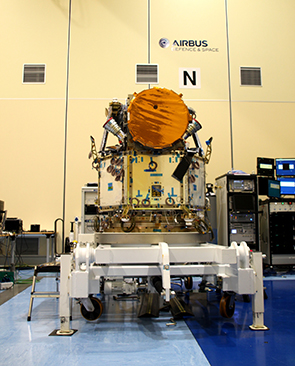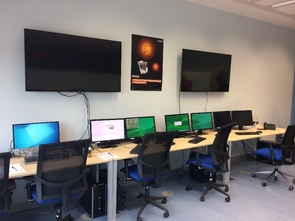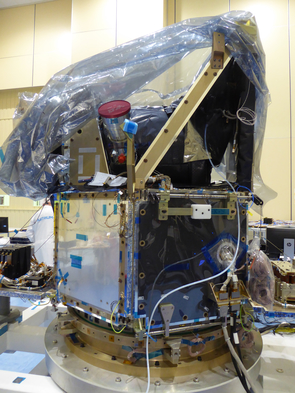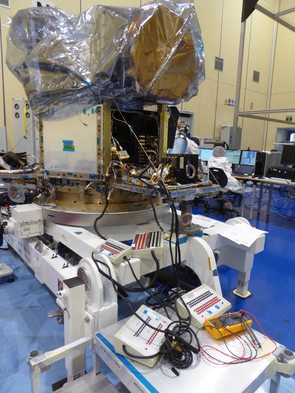#12: From star positions to images: CHEOPS operations centres pull together
5 July 2018
The latest CHEOPS test campaign can be thought of as the first full dress rehearsal for in-flight mission operations. |
| The integrated CHEOPS satellite. Credit: Airbus 2018 |
In May, scientists at the Science Operations Centre (SOC) at the University of Geneva, Switzerland, were able to instruct the instrument on the CHEOPS satellite, currently located at Airbus Defence and Space Spain in Madrid, to expose the Charge Coupled Detector (CCD) and to retrieve the resulting image. Previous tests have not involved the SOC, so this is the first time that such an end-to-end operation has been demonstrated.
This test campaign, which combined the SVT-2 (System Validation Test 2) with the SOVT (System Operational Validation Test), was completed during seven days of coordinated effort between Geneva, the Mission Operations Centre (MOC) in Torrejón, Spain, and Madrid. It is the penultimate System Validation Test (SVT) in the series of tests reported in CHEOPS journals #4 (SVT-0), #8 (SVT-1A) and #10 (SVT-1B).
Gathering data with CHEOPS will be extremely efficient because the telescope will observe stars with known planets: the orbital periods of these planets are also known and observations can therefore be made at just the right time to catch the dimming caused by planetary transits. The scientists responsible for mission planning at the SOC will use the planet ephemerides to draw up a detailed activity plan to tell the spacecraft where to point in the sky and when.
 |
| Inside the CHEOPS Mission Operations Centre. Courtesy of INTA-ES |
The activity plan will be defined on a weekly basis and uploaded to the spacecraft via the MOC. There, telescope operators will verify that the activity plan can be executed correctly, for example, by checking that the telescope always points more than 120 degrees away from the direction to the Sun, before converting it to telecommands and transmitting them to the spacecraft.
New data gathered by the satellite will be sent to a ground station and relayed back to scientists at the SOC via the MOC. There are two CHEOPS ground stations near Madrid, the main one is located in Torrejón and a back-up is located in Villafranca.
The goal of the SVT-2/SOVT campaign was to test and validate the entire end-to-end process described above, including simulating data transmission during ground station passes. It was also possible to validate the critical sequence of events that will be performed in the first days after launch and in the subsequent two months, when the spacecraft platform and the science instrument are readied for the science operations.
Of course, no astronomical images could be acquired during the tests, since the telescope was in the cleanroom and not pointing towards the sky. For the purpose of this campaign, it was sufficient to ensure that the science instrument could be instructed to acquire dark images with the baffle cover closed, and that these could be correctly transmitted from the cleanroom in Madrid to the SOC in Geneva.
The results of the latest tests demonstrate that the mission is ready to progress to the next phase. Now that the mechanical and electrical integration of the telescope with the platform is complete, preparations for a series of environmental tests are underway.
 |
 |
| The integrated CHEOPS flight hardware. Credit: ESA | Performing electrical testing on the integrated CHEOPS satellite. Credit: ESA |
Now fully-integrated, the spacecraft is being shipped in July to Airbus EVT in Toulouse, France, to undergo thermal tests. It will then travel on to RUAG in Zurich, Switzerland, for vibration tests, and further to ESA's technical centre in The Netherlands, for acoustic and electromagnetic compatibility tests. Finally, it will come back to Airbus Defence and Space Spain in Madrid, where the last system validation test (SVT-3) will be performed to check readiness for the launch and early operations phase of the mission.
As the spacecraft moves from country to country, and from test to test, it is an exciting period for the CHEOPS team as they scrutinise every detail of the mission to ensure that the spacecraft is primed and ready before shipment to Europe's Spaceport in Kourou, French Guiana.
About CHEOPS
CHEOPS is an ESA mission implemented in partnership with Switzerland, through the Swiss Space Office (SSO). The University of Bern leads a consortium of 11 ESA Member States contributing to the mission and represented in the CHEOPS Science Team. ESA is the mission architect responsible for overall mission definition and procurement of the spacecraft and launch. ESA is also responsible for the early operations phase that will be executed by the spacecraft contractor, Airbus Defence and Space–Spain (ASE). The science instrument is led by the University of Bern, with important contributions from Austria, Belgium, Germany and Italy. Other contributions to the science instrument, in the form of hardware or science operations, are provided by Hungary, France, Portugal, Sweden, and the United Kingdom. CHEOPS will be launched from Europe's spaceport in Kourou, French Guiana, on a Soyuz rocket operated by Arianespace. Following successful in-orbit commissioning of the spacecraft, responsibility for operations will be taken over by the CHEOPS Mission Consortium, with the Mission Operations Centre under the responsibility of INTA, Spain, and the Science Operations Centre led by the University of Geneva, Switzerland.




